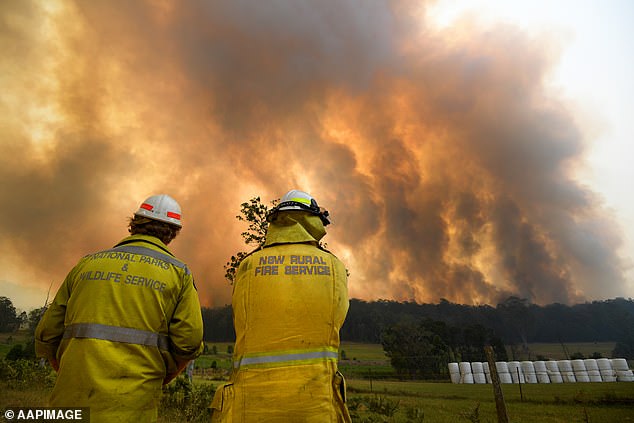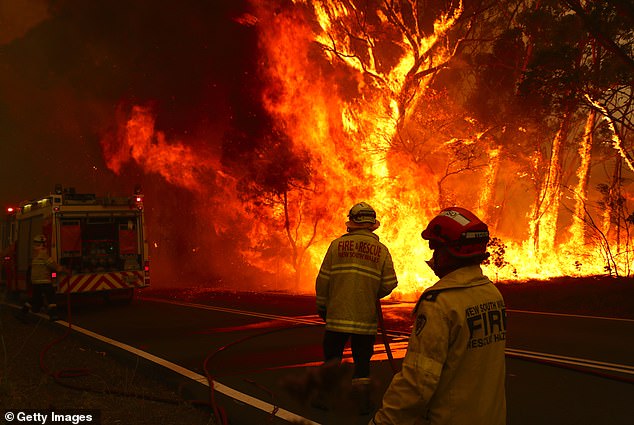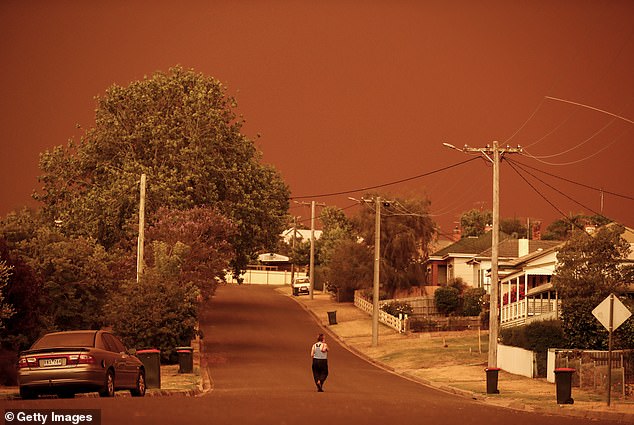The terrifying map that spells danger for millions as Aussies brace for devastating bushfire season
A map of the areas most prone to bushfires in Australia was unveiled this summer could rival that of the devastating bushfires of 2019-2020.
The map was released by the Australian Fire Authorities Council (AFAC) on Thursday and highlighted huge areas across the country at ‘increased risk of fire’.
AFAC believes record-breaking dry conditions in winter and a warmer-than-average start to spring have left the country susceptible to large-scale wildfires.
Large parts of New South Wales, Queensland and the inland Northern Territory have been identified as potential bushfire outbreaks.
Meanwhile, every other state and territory other than the ACT also has regions under threat.
A map of Australia’s most bushfire-affected areas (pictured) shows the country is in for a summer to rival that of the destructive Black Summer of 2019-2020.
Almost all of Queensland has been identified as high risk this summer, with only some areas along the coast and the South Australian border not highlighted.
After experiencing numerous fires before the start of summer, the coastline, northeast and central New South Wales are also in the line of fire this summer.
AFAC also highlighted that large areas covered in dry grass in the Northern Territory’s interior, including Alice Springs and as far north as Elliot, are contributing to a higher risk of bushfires.
Although not as vast as NSW, Queensland or the NT, major cities such as Perth, Adelaide, Melbourne and Hobart are all in or close to vulnerable regions.
The south-west coast of Western Australia, including the Margaret River and Albany, was found to be at risk.
A stretch of land stretching just west of Melbourne and reaching along the coast through Geelong, almost to Portland, was found to be at increased risk, as was the east of the state around Genoa.
Meanwhile, a small area in Tasmania, northwest of Hobart, appeared to have become much drier than normal, which could lead to a bushfire.

Many of the areas at risk of bushfires this summer were in the middle of the Black Summer fires just three years ago (photo: firefighters during Black Summer)
AFAC boss Rob Webb said the map should give Aussies more than enough warning to prepare for this summer’s bushfire season.
“Wherever you live, work or visit this summer, know where to find bushfire information, prepare your property and talk to your family and friends about what you will do in an emergency,” he said.
He said firefighters were busy extinguishing fires across the country well before the start of summer.
Mr Webb urged Aussies to help their local fire brigades by preparing for bushfires before the fire season starts.
However, AFAC noted that the map should only be used as a guide, warning that the likelihood of forest fires forming and spreading, even on small scales, varies widely.
“State and Territory fire authorities will continue to closely monitor local bushfires throughout the summer,” read a statement from the council.
‘Communities must remain informed and prepared and consult official sources for advice and warnings.’
Some of the high-risk areas for this fire season were also in the middle of the Black Summer fires three years ago.
Most of the country’s east coast has since been hit by mostly wet and cold weather, meaning the charred remains of the deadly wildfires have been rejuvenated.
But the return of El Nino this year, mostly dry and hot, has since left these areas looking more like kindling.

During Black Summer (pictured), around 100 bushfires destroyed around 21.4 million hectares of land between July 2019 and May 2020 – mainly in Victoria, NSW and the ACT.

The wildfires destroyed just under 2,800 homes, killed 34 people and resulted in the deaths of an estimated 3 billion animals, while affecting about 80 percent of the nation.
The same had happened during the summer of 2019-2020, when droughts gripped the country three years earlier and left parts of the country bone dry.
In areas such as Bega and East Gippsland, along the coastal areas of the Victoria-New South Wales border, about 60 percent of the land has been burned.
To make matters worse, Bega was also hit by heavy flooding and Covid-19 lockdowns, which resulted in four deaths and around 500 houses destroyed.
From June 2019 to May 2020, a total of 21.4 million hectares of land – mainly in Victoria, NSW and the ACT – was burned.
The fires destroyed just under 2,800 homes, killed 34 people and resulted in the deaths of an estimated 3 billion animals.
Economists believe the fires are among the most devastating in Australian history. This will affect around 80 percent of Aussies and cost between $78 billion and $88 billion in property damage and economic losses.
